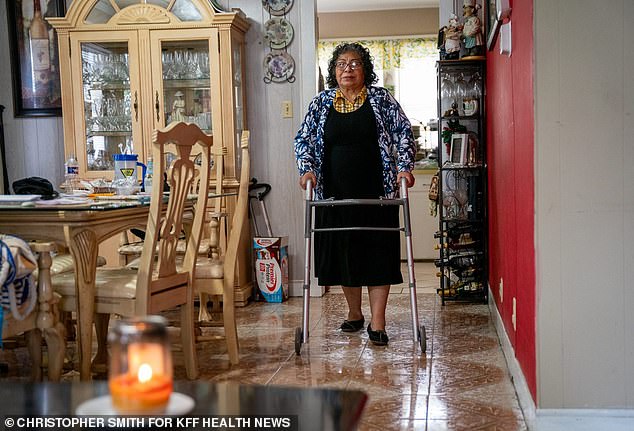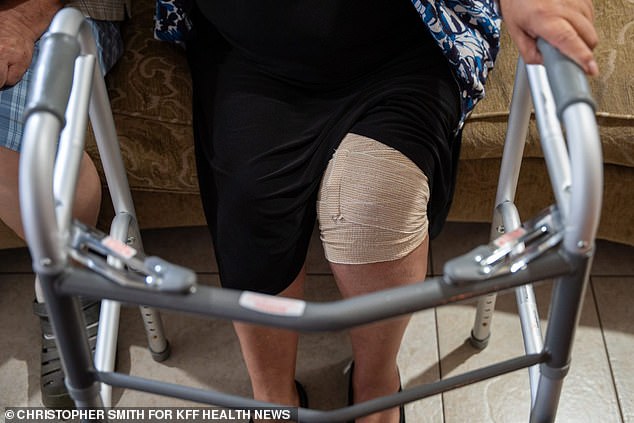Three Super Bowl shooting victims reveal how they are adjusting to life with bullets STILL in their bodies
When two men opened fire during the Chiefs’ Super Bowl parade in 2024, the joy quickly gave way to chaos.
Those men killed one woman and injured another 24 people, causing a wave of destruction throughout the community.
Three of the victims of that day have spoken out for the first time and showed how the horror lives on with them – literally.
They are still adjusting to life with bullet fragments in their bodies.
James Lemons, 39, lost his job as a warehouse worker due to a gunshot wound to his right thigh.
The youngest victim, Mireya Nelson, 15, lives with bullet fragments scattered in her shoulder, but trusts the doctor’s decision to leave the bullet in even as she undergoes painful physical therapy.
Sarai Holguin, 71, has accepted her bullet as a ‘friend’, despite the fact that it prohibits her from seeing her elderly father and makes her foot difficult to move.
These three survivors are emblematic of a larger debate in the medical community – whether it is right for doctors to leave bullets in someone’s body after they have been shot.
They can do this for several reasons. First, cutting a bullet out of someone who has already been seriously injured can cause more damage, blood loss, and trauma than necessary – especially if the bullet hits an area that doesn’t cause damage.
On the other hand, if the bullet is difficult to reach because it is close to important anatomical structures such as blood vessels or nerves, doctors may leave it in.
According to the report, 42,967 Americans died from gun wounds in 2023 National Institute for Healthcare Management. Yet only 15 percent of hospitals have bullet disposal policies. This is reported by the Kaiser Family Foundation.
According to a 2021 study, people who leave the hospital with bullets still in their bodies are more likely to return to the emergency room within six months of their initial injury than those who have their bullets removed. Washington University in St. Louis.
Doctors chose to leave bullets or fragments thereof in the fans of these three Chiefs, who ended up in hospitals on that fateful day in February.
Mr. Lemons and his daughter Kensley during the parade.
Mr. Lemons had hoisted his daughter onto his shoulder and was watching the celebration when he was shot in the back of his right thigh during the parade.
After performing a scan of his leg, doctors discovered that the bullet had narrowly missed major blood vessels and lodged in a part of Mr. Lemon’s thigh where they thought he would heal easily.
So they sent him home with the slug still buried in his leg.
But for Mr. Lemons, who has a warehouse job that regularly involves moving 100-pound packages around the workplace, this was far from the truth.
The pain the bullet caused in his leg made it difficult to walk, let alone work.
So he lost his job and with it his insurance.
This caused him great difficulty – not only in dealing with the trauma of being shot, but also the pressures of caring for a family on a single income and mounting medical debt.
The $1.9 million in funds raised for the victims of the SuperBowl shooting by United Way have yet to be made available to families like the Lemons.
Instead, they rely on donations to a GoFund that I can pay for Mr. Lemons’ bullet removal surgery later this month.
Fortunately for Erika Nelson, the mother of 15-year-old parade victim Mireya Nelson, her job in healthcare provides solid insurance that paid for Mireya’s treatments.
During the parade, Mireya was struck by a bullet that hit her chin and passed through her jaw into her shoulder before exiting through her arm.
After treating the initial wounds, her doctors decided the teen had undergone enough surgery and opted to leave bullet fragments in her shoulder. “I don’t really care about them,” Mireya said.
Now Mireya visits a therapist at her mother’s request, but her only complaint is that physical therapy is sometimes painful. She also notes that the scars on her chin are bumpy.
Erika, like any mother, worried about the psychological toll this would take on her daughter, but ultimately decided the doctors had made the right decision.
‘I don’t want her to have to stay in the hospital and have to have surgery again and again. That means more trauma for her and more recovery time, more physical therapy and things like that,” Erika said.

Ms. Holguin’s foot has not acted the same since she was shot. Her foot dangles limply and she has difficulty moving her toes.

Mrs. Holguin lives with a bullet in her knee.
In some cases, people are able to adjust to their new lives with a foreign body along for the ride. That’s what happened to Mrs. Holguin.
Ms Holguin was shot near her knee during the parade and was quickly helped to hospital by ‘anonymous heroes’. There, doctors decided the best way to care for her was to leave the bullet in, perform some damage control surgery and repair her wound with a device called WoundVac.
This high-tech device is attached to a gentle vacuum that releases pressure so a large wound can heal faster, according to Johns Hopkins. The device costs about $800 per month.
For several weeks, Ms. Holguin visited doctors almost daily to monitor her progress.
Between those visits, the WoundVac and the initial surgeries, the bills quickly piled up for Ms. Holguin.
The Mexican native who became a U.S. citizen in 2018 struggled to understand the complex bills and forms that arrived in her mailbox, but was able to get help through her local consulate.
Once she was able to secure payment for her medical bills through the Jackson County Victim Fund, her distress in dealing with the event was assuaged.

The Chiefs Parade took place in February 2024 at Union Station in downtown Kansas City, Missouri.
She said now, she and her bullet, “became friends so she won’t hurt me anymore.”
Still, she can’t travel to see her father in Mexico, and she has trouble moving her foot. But she moves forward in her new reality, with her new friend, the bullet, permanently inside her.
“I have incorporated this new chapter into my life,” Holguin said. “I have never given up and I will continue with God’s help.”
Despite how common it is for doctors to leave bullets in bodies, some providers question their validity.
Leaving a bullet in a body sometimes leads to further physical and psychological complications, Dr. LJ Punch, a trauma surgeon based in St. Louis, told KCUR.
In terms of the physical, if a bullet contains lead, the chemical can enter the bloodstream over time. According to the CDC. Chronic exposure to lead can lead to nerve damage, brain damage and death.
Then there are the cases where the bullet becomes infected. Other times it can protrude from the skin like a splinter, which is painful and unsightly for many patients.
Also, the scar tissue that forms around a bullet in a person’s body can sometimes put pressure on nerves, ligaments, or muscles, impairing movement or making it painful.
The psychological toll of keeping a bullet in someone’s body is another concern doctors should take into account, pediatric surgeon Dr. Brendan Campbell, a pediatric surgeon, at KCUR.
“A lot of times it’s the emotional, psychological wounds that take a lot of these patients away as well,” he said.
Leaving a bullet in someone’s body can be a physical reminder of what he or she has experienced.
And “when people dwell on their trauma, that trauma can change them for a lifetime,” Dr. Punch added.
33 percent of gun violence survivors report living in fear that the event will happen again Research from EveryTown. 43 percent of survivors reported needing psychological support after experiencing gun violence.
Yet many gun violence survivors are sent back into the world without resources, with mounting bills and still another bullet in their body, just like the Chief’s fans.
“Trauma care is war medicine,” Punch said. ‘It is ready to be ready at any time, at any time, every day, to save a life. It is not equipped to provide the healing that must come next.”
